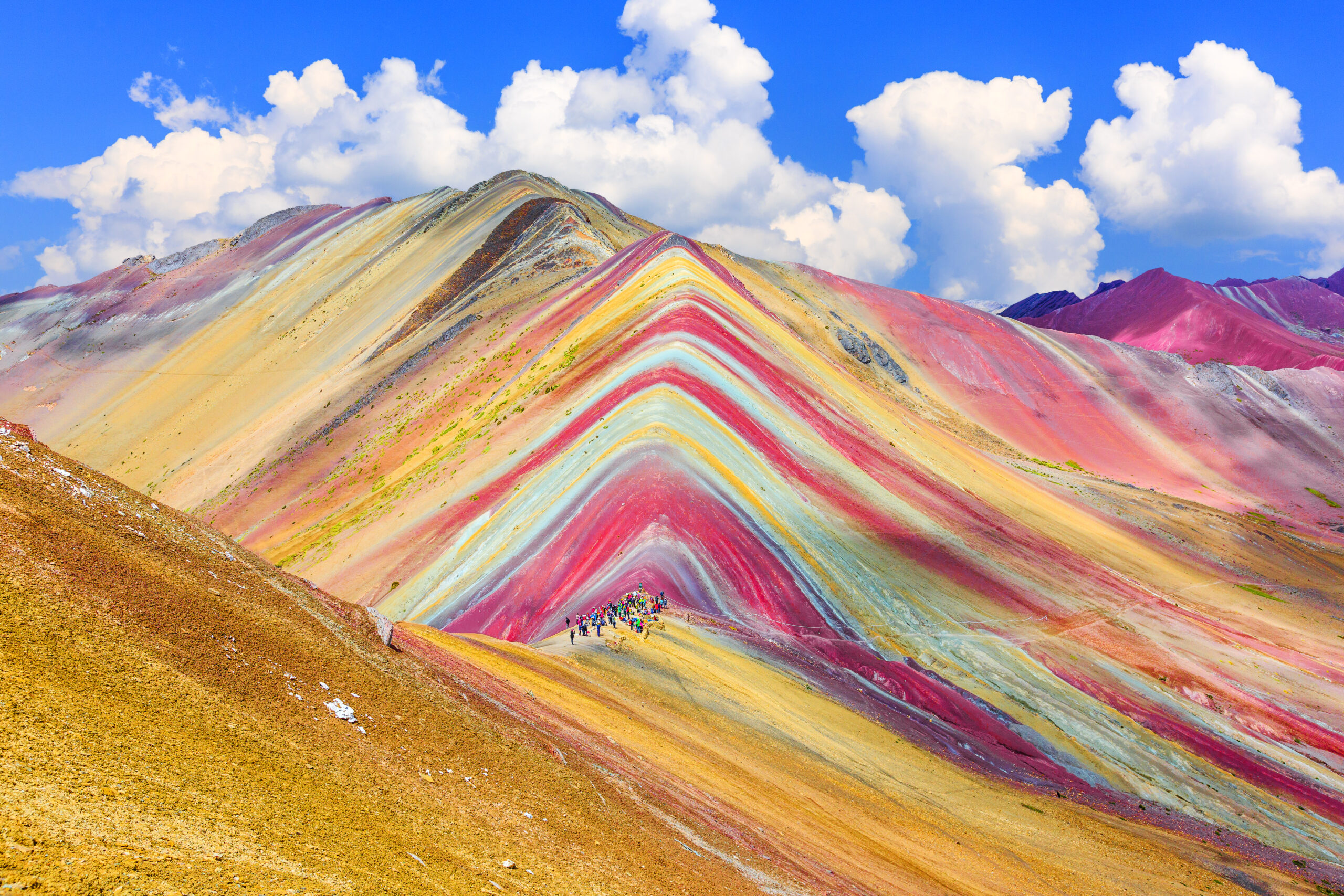Peru is a country that feels ancient even as it breathes in the present — a place where every stone, mountain, and whisper of wind seems to remember something sacred. From the luminous peaks of the Andes to the green infinity of the Amazon, from the high plains of the altiplano to the Pacific’s restless edge, Peru is not one world but many, stacked layer upon layer like the terraces of its Incan ruins.
To travel here is to pass through centuries in a single day. Dawn might find you in a colonial plaza paved with cobblestones, noon amid clouds that veil Machu Picchu, and dusk beneath the orange skies of the desert coast where seabirds wheel over ancient geoglyphs. Yet beyond geography and history, Peru’s real treasure is its living soul — a fusion of Inca and Quechua tradition, Spanish inheritance, and a fierce modern creativity.
Its cuisine alone tells a story of continents meeting: ceviche kissed by lime, lomo saltado seared in a wok’s flame, corn and potato in forms uncountable. Its music is a heartbeat — the quena’s melancholy cry mingling with Afro-Peruvian rhythm.
But above all, Peru is a land of wonder that asks its visitors not merely to look, but to listen — to the silence of the Andes, the pulse of the rainforest, and the echoes of civilizations that never truly vanished.
Here, history is not past. It is alive, waiting for you at every turn.
Lima – The City of Kings and Contrasts
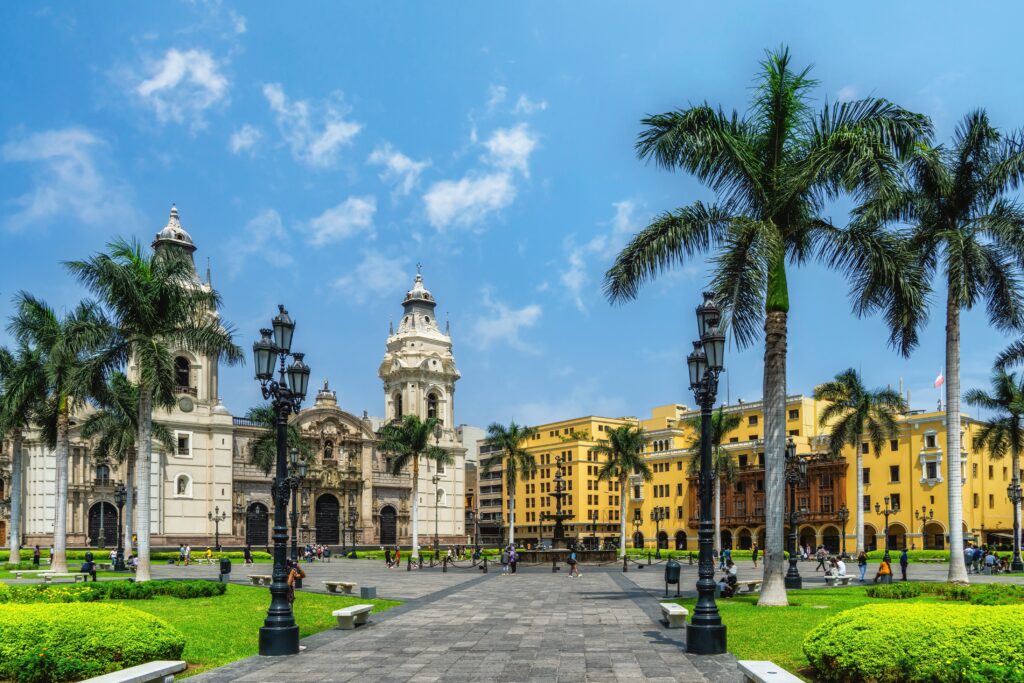
Perched above the Pacific cliffs, Lima is a city of paradoxes — colonial splendor beside modern energy, misty mornings fading into golden sunsets. Founded by Francisco Pizarro in 1535, its heart, the Plaza Mayor, still glows with baroque façades and carved balconies that seem to hold their breath above the square.

Yet Lima is also the soul of contemporary Peru. In Barranco, bohemian murals bloom across crumbling mansions, and cafés echo with guitar strings and laughter. In Miraflores, glass towers watch surfers ride the Pacific’s restless waves. The city’s pulse is its cuisine: from cevicherías that turn lime and sea into poetry, to world-renowned restaurants like Central and Maido, where chefs reinterpret Peru’s biodiversity as art.

Lima does not charm quickly; it unfolds like fog — slow, soft, and inevitable. Stay long enough, and you’ll sense its rhythm: a metropolis that lives in both centuries at once, always looking seaward toward the horizon.
Cusco – The Navel of the World
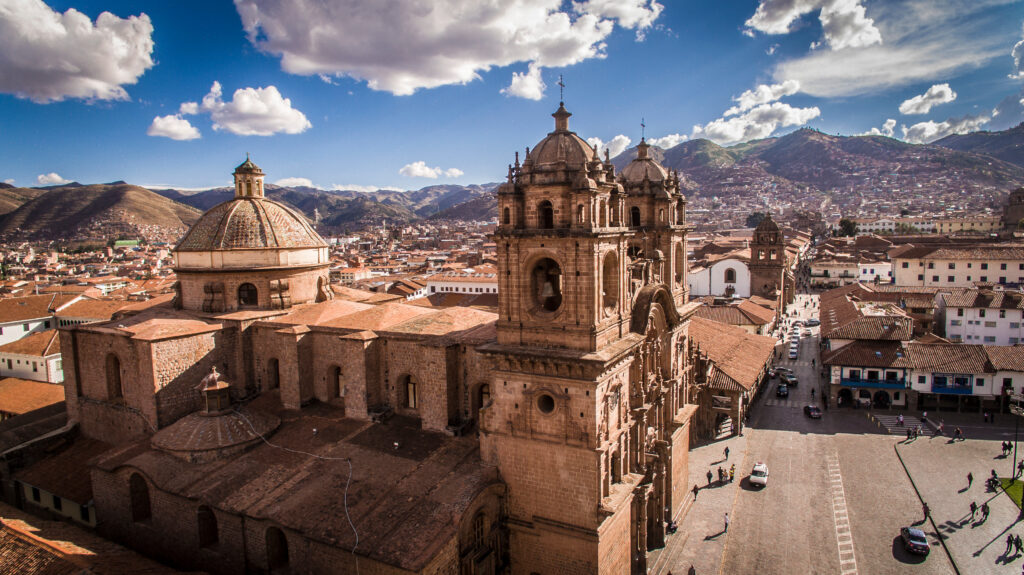
Once the glittering heart of the Inca Empire, Cusco still feels like the center of something cosmic. Its streets rise and fall with the contour of mountains, lined with Inca stone walls so precisely fitted that even time cannot pry them apart. Above them, colonial churches glow with gold leaf and saints carved in local likenesses — symbols of conquest transformed into continuity.

Every step here is layered: temples beneath cathedrals, myths beneath maps. In the Qorikancha, where the Incas once worshipped the Sun, sunlight still slips across ancient masonry with reverence. Beyond the city, the Sacred Valley stretches — a corridor of maize fields, terraced slopes, and river songs leading toward Machu Picchu.
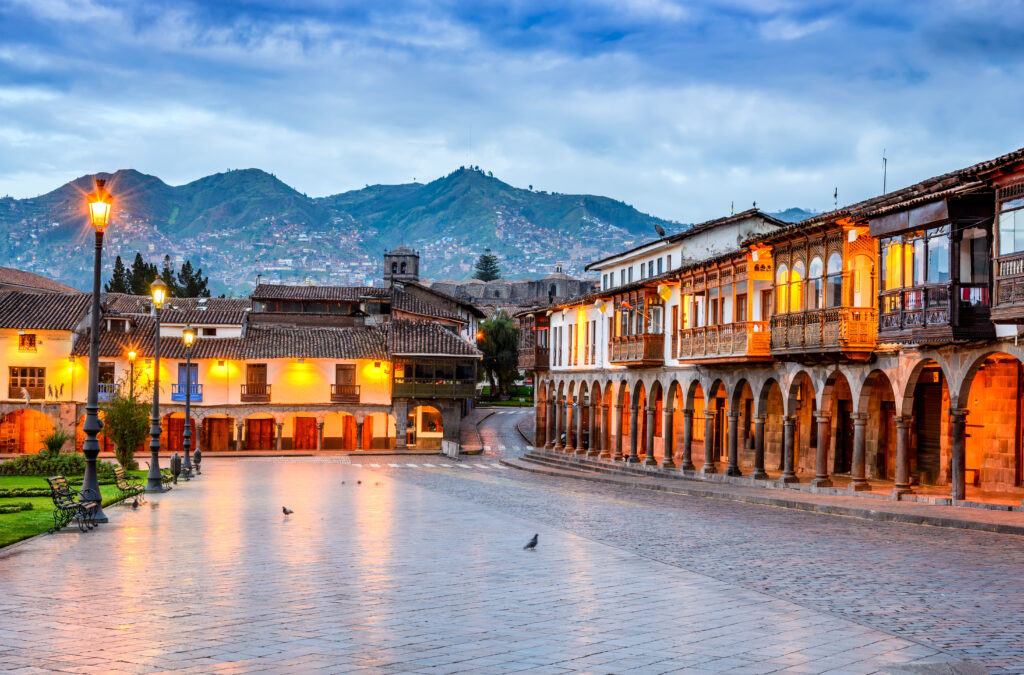
Yet Cusco is more than a relic. Its markets buzz with color, its festivals with dance and devotion. At night, when the stars gather like Inca constellations above the rooftops, you feel it — that the navel of the world is not a legend. It is alive beneath your feet.
Machu Picchu – The Lost City in the Clouds
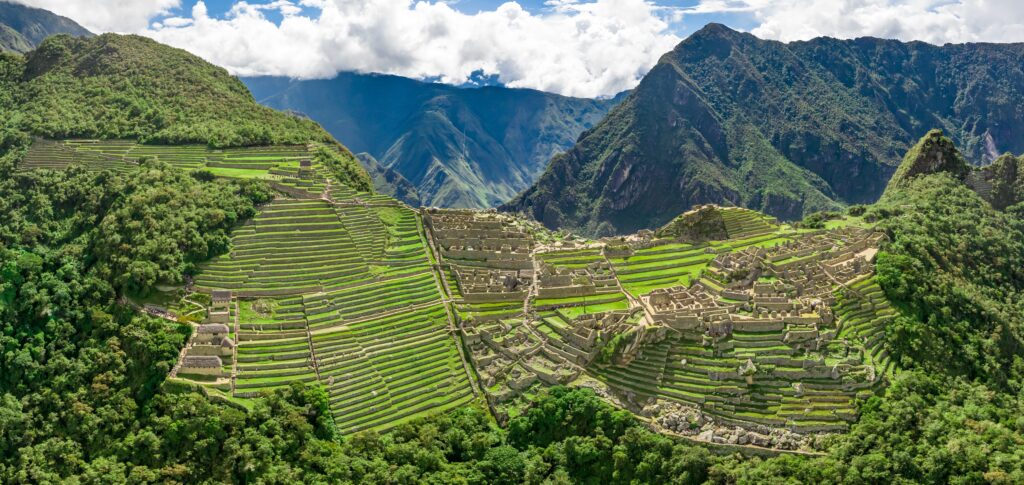
No matter how many times you’ve seen its image, Machu Picchu steals your breath in ways no photograph can foretell. Hidden among Andean ridges and clouds that seem to guard its secret, it feels less like a ruin and more like a revelation.
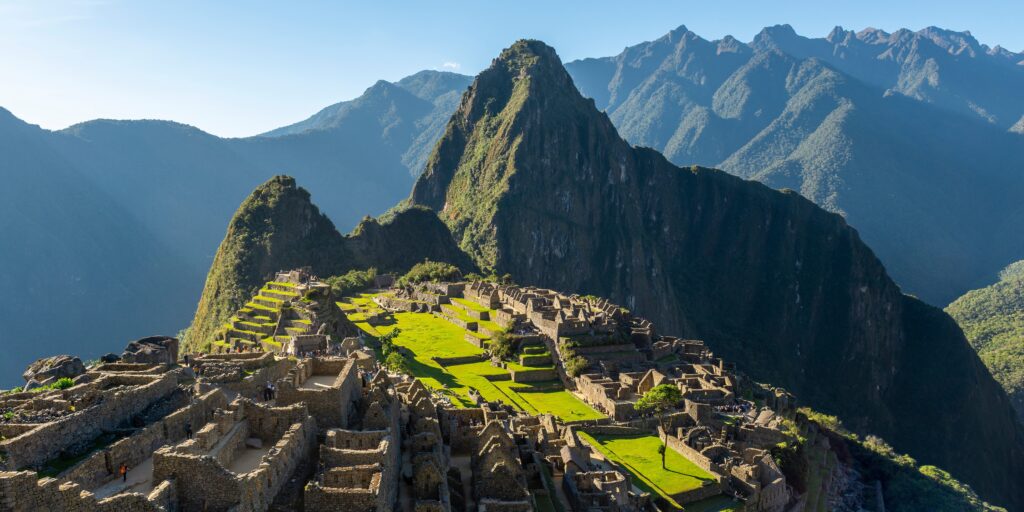
Built in the 15th century and abandoned before the Spanish arrived, Machu Picchu was never truly lost — only waiting. Its terraces cling to cliffs, its temples align with the sun, and its stones hum with geometric perfection. At dawn, mist drifts through the Intihuatana — the “Hitching Post of the Sun” — and the whole city seems to awaken.
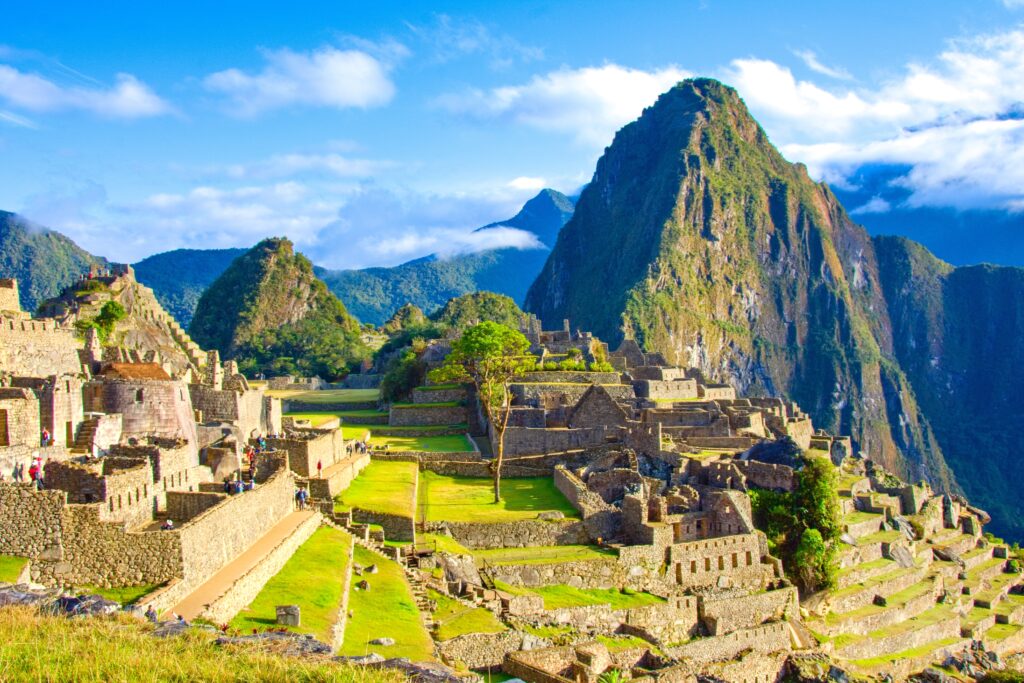
The journey here is part of its magic. Whether by the Inca Trail, winding through orchid-laced forests, or by train through the Urubamba Valley, each path feels like an initiation. When you stand at the Sun Gate and see the citadel unfold below, time dissolves — and you understand why some places are not built to impress, but to illuminate.
The Sacred Valley – Heartbeat of the Andes

Between Cusco and Machu Picchu, the Sacred Valley opens like a green artery through the mountains. Once the agricultural and spiritual center of the Inca world, it remains one of Peru’s most beautiful landscapes — a tapestry of rivers, villages, and ancient terraces that still feed the earth.
In Pisac, artisans sell silver and woven textiles beneath Inca ruins that gaze down like silent guardians. In Ollantaytambo, a living Inca town, narrow alleys follow the same lines as they did six centuries ago. The terraces climb the hillsides in a golden geometry of sun and stone.

But the valley’s rhythm is not only history — it’s human. Farmers tend fields with centuries-old methods; children herd llamas through emerald slopes. The air here feels thinner, purer, touched by mountain prayer. To visit the Sacred Valley is to glimpse a world where land, labor, and faith are one — and where time still walks at the pace of the wind.
Arequipa – The White City Beneath the Volcanoes
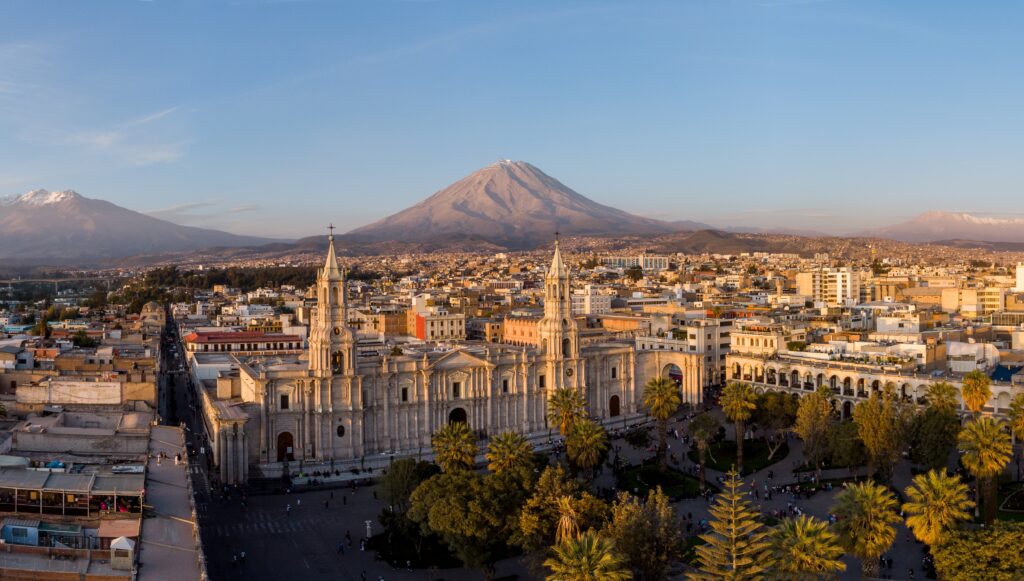
Cradled between three volcanoes, Arequipa is a city of light — its buildings carved from white volcanic stone that glows amber at sunset. Known as La Ciudad Blanca, it carries both colonial elegance and Andean pride.
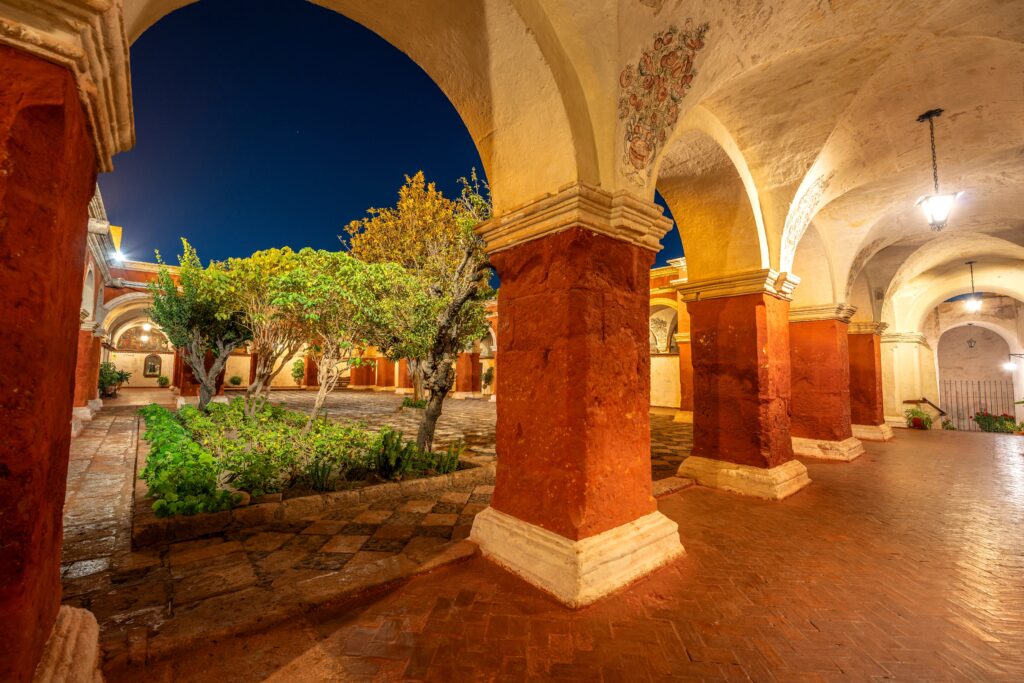
The Plaza de Armas is among the most beautiful in South America, framed by arched colonnades and dominated by the twin towers of the Cathedral. Nearby, the Santa Catalina Monastery is a city within a city — a labyrinth of blue and ochre cloisters, where silence lingers like incense.

Beyond its architecture, Arequipa pulses with intellectual and culinary life. The markets overflow with rocoto relleno and queso helado, while the surrounding landscapes — from the Colca Canyon to the smoking peak of El Misti — reveal nature’s drama in full measure.
Arequipa stands apart yet mirrors Peru itself: elegant, volcanic, eternal.
Lake Titicaca – The Sacred Mirror of the Sky

At over 3,800 meters above sea level, Lake Titicaca seems less a body of water than a sky made liquid. The Incas called it the birthplace of the sun, and when you watch dawn’s first light spill across its surface, you understand why. The lake stretches endlessly between Peru and Bolivia, an ocean among mountains, where every ripple seems to carry myth.
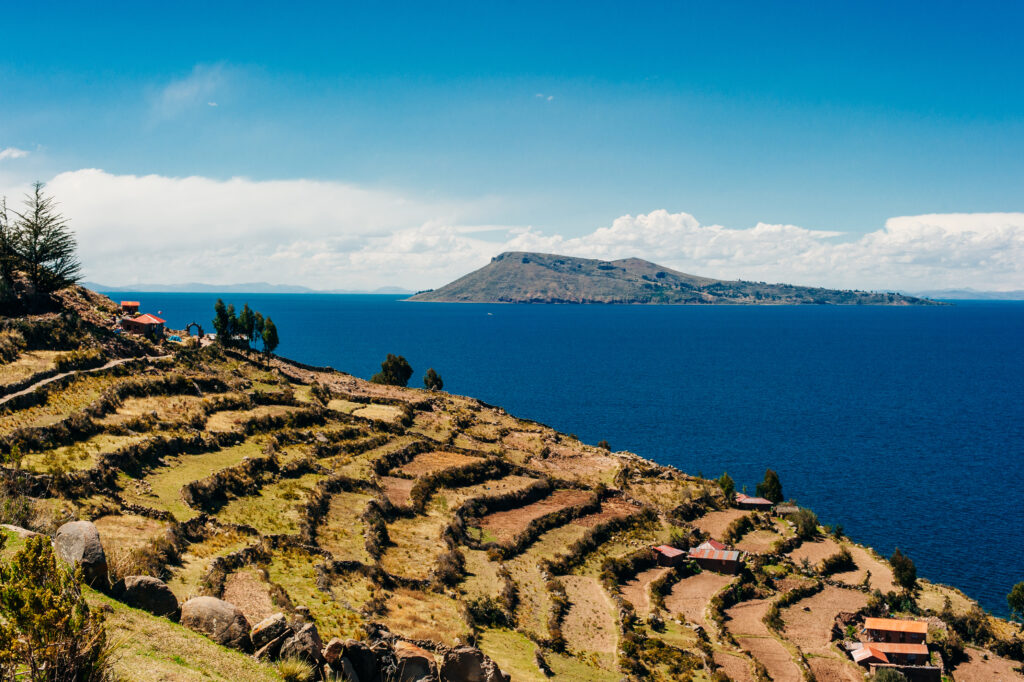
The Uros Islands, woven from totora reeds, float upon the water like dreams. Entire communities live upon them, crafting homes, boats, and even the ground beneath their feet from the same golden reeds that sway in the breeze. Nearby, Taquile Island rises like a green crown — its terraces spiraling upward, its people preserving traditions as old as the lake itself.
At night, when the stars reflect perfectly on the surface, sky and water merge into one boundless infinity. Lake Titicaca is not a destination; it’s a revelation — a place where altitude feels sacred, and silence speaks.
Puno – Gateway to the Altiplano
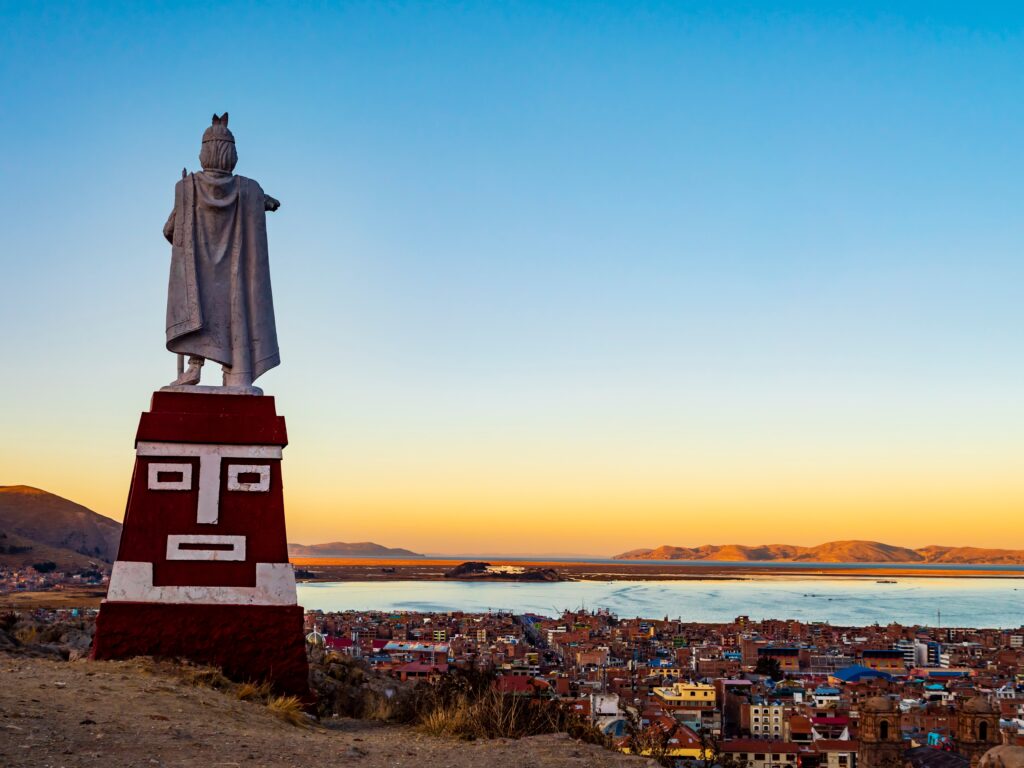
The city of Puno, perched on the lake’s western shore, is the human heart of the high plateau — a kaleidoscope of colors, music, and devotion. Though modest in size, it carries a spirit vast as the landscape around it. Every February, the Fiesta de la Candelaria transforms its streets into a whirlwind of costume and dance — a celebration that fuses Catholic faith with ancient Andean ritual.

From Puno, the altiplano stretches endlessly: plains of gold and wind, dotted with alpacas and adobe villages that seem to have grown from the earth itself. The people here endure cold and altitude with grace, their faces weathered like carved stone, their songs carried by the wind.
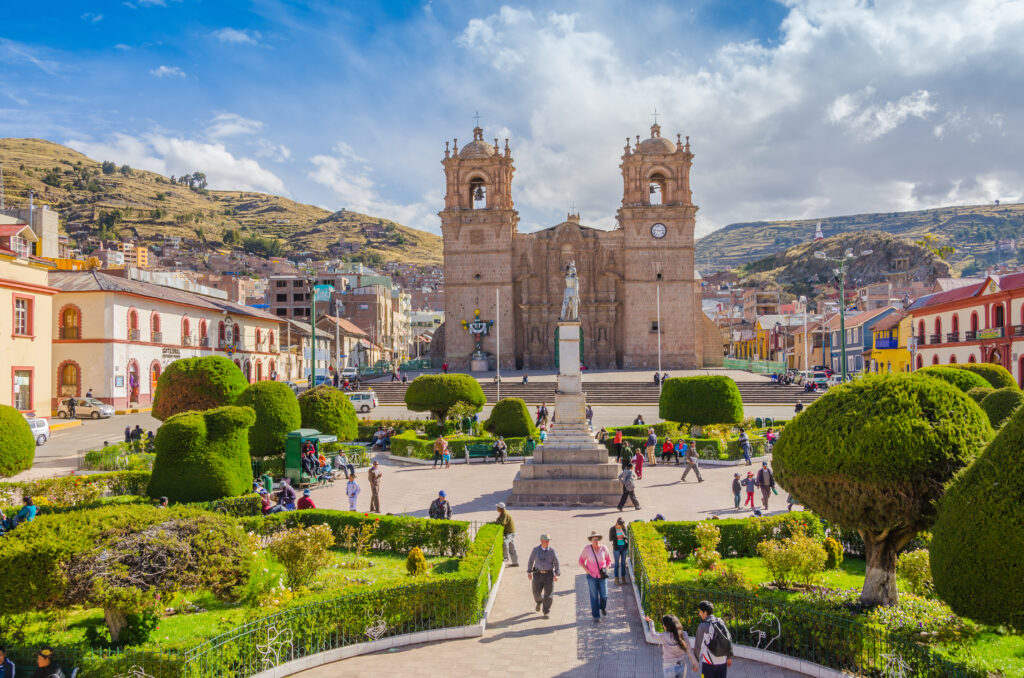
Puno’s charm lies not in grandeur but in soul — in how it bridges two worlds: the mythic and the real. It is the port of the heavens, the prelude to Titicaca’s silence.
Nazca – Lines of the Unknown

Few places on earth invite as much wonder — or speculation — as the Nazca Lines. Etched across a desert plain more than a thousand years ago, these enormous geoglyphs — hummingbirds, monkeys, spirals, and geometric forms — can only be truly seen from the air. From above, they seem messages drawn for the gods rather than for men.

The Nazca civilization carved them between 500 BCE and 500 CE, perhaps as offerings to celestial beings or to summon water from the arid land. Whatever their purpose, their precision remains astounding: perfectly straight lines, figures that stretch for hundreds of meters, all enduring millennia of sun and sand.
Beyond the lines, the desert itself tells stories — of survival, ingenuity, and reverence for forces unseen. The Chauchilla Cemetery, with its ancient mummies, reveals a people who believed in eternity. Nazca is the place where art meets mystery — and where the earth itself becomes a canvas of faith.
Paracas – Where the Desert Meets the Sea

South of Lima, the Paracas Peninsula is where two worlds collide — the ochre stillness of the desert and the teeming life of the Pacific. The Paracas National Reserve protects this fragile harmony, its cliffs plunging into turquoise waters alive with seals, flamingos, and seabirds that trace ancient routes across the wind.
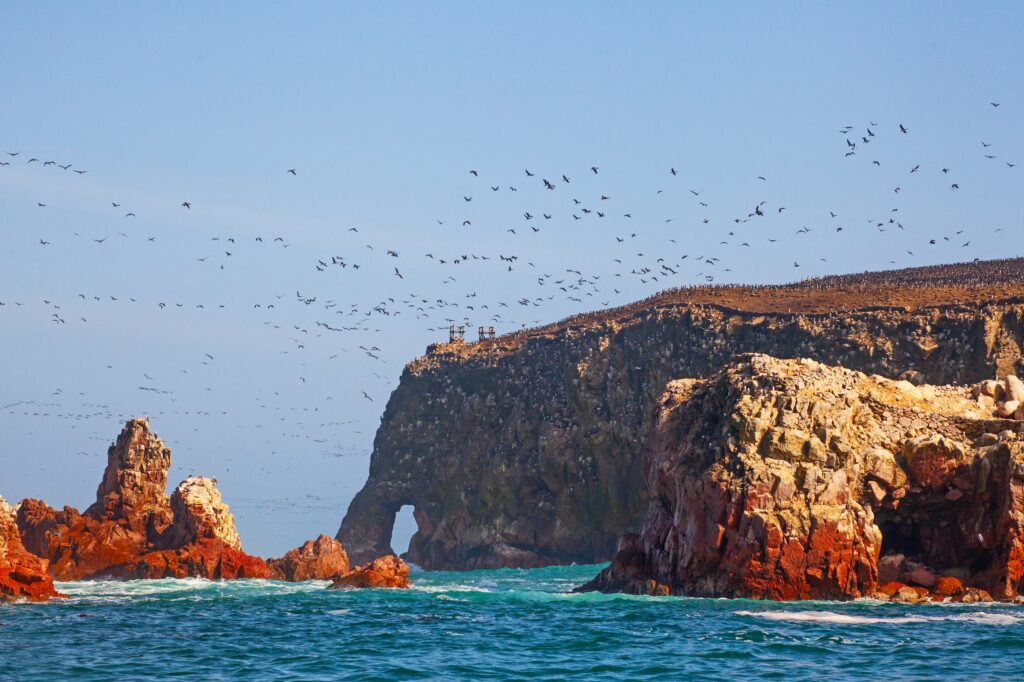
Offshore lie the Ballestas Islands, often called “the poor man’s Galápagos.” Here, penguins nest beside pelicans and sea lions bask in the sun, their cries echoing against stone arches sculpted by the ocean. On the mainland, the mysterious Candelabro, a vast geoglyph carved into a sand dune, points seaward like a cosmic compass.
Paracas is a place of silence and salt — where life thrives against all odds, and the line between land and sea feels as fluid as time itself. At sunset, when the desert turns crimson, you sense that this is not emptiness but eternity.
The Amazon Basin – Green Infinity

To the east of the Andes, the mountains dissolve into a sea of green — the Peruvian Amazon, one of the planet’s greatest sanctuaries of life. From Iquitos in the north to Puerto Maldonado in the south, the rainforest unfolds in endless layers of river and canopy, a living cathedral where sunlight filters like stained glass through leaves.
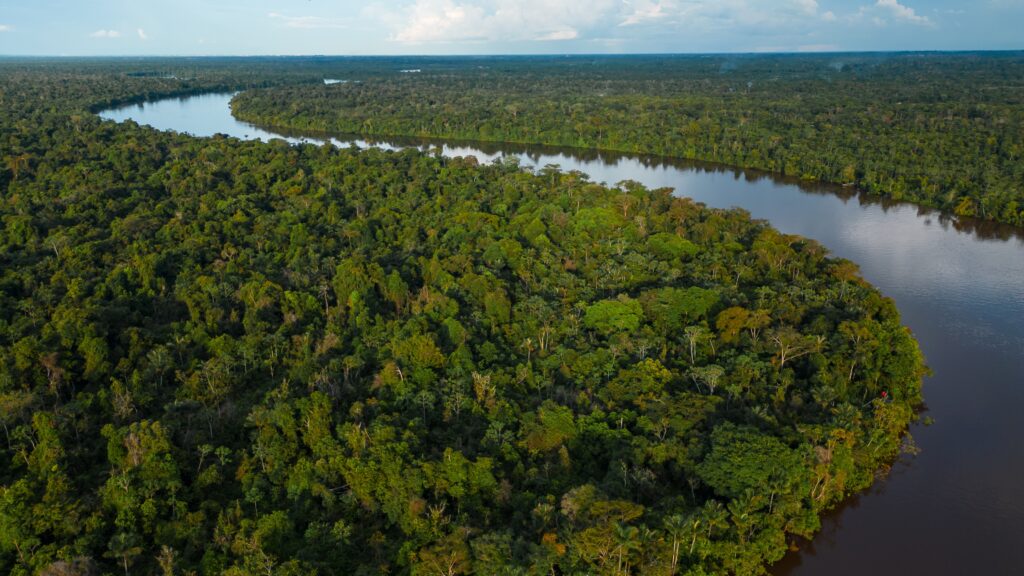
Here, the air hums with insects and birdsong, and the river — the mighty Amazon — moves like liquid time. Pink dolphins break the surface; macaws blaze across the sky; the forest breathes with ancient intelligence. Indigenous communities live within its rhythms, their knowledge of plants and medicine as deep as the roots beneath their feet.
To travel the Amazon is to enter a world that resists definition. Days are measured not by hours but by the play of light, the cry of distant monkeys, the sudden silence before rain. The forest doesn’t speak in words — it listens. And when you finally leave, part of you stays behind, caught in that eternal whisper of green.
Trujillo – City of Eternal Spring

Bathed in gentle coastal sunlight, Trujillo is known as La Ciudad de la Eterna Primavera — the City of Eternal Spring. Its colonial core glows with pastel façades and baroque churches, while the surrounding desert holds echoes of civilizations long vanished but never forgotten.
Founded by conquistadors, Trujillo nonetheless feels deeply Peruvian. Its Plaza de Armas is one of the most beautiful in the country — wide, graceful, framed by the golden towers of its cathedral. Yet the true wonders lie just beyond the city: the immense Huaca del Sol and Huaca de la Luna, twin adobe pyramids of the Moche culture, still marked with vivid murals of gods and warriors.

Trujillo dances to the rhythm of marinera, Peru’s national dance, its swirling skirts and playful courtship reflecting both elegance and pride. It’s a city where joy feels effortless — where the air itself carries the promise of renewal.
Chan Chan – The Clay Citadel of the Chimú

Just outside Trujillo lies Chan Chan, the ancient capital of the Chimú Empire and the largest adobe city in the world. Its vast walls rise from the desert like waves frozen in time — nine palaces connected by corridors, courtyards, and ceremonial plazas that once shimmered with gold.

Built around the 9th century, Chan Chan was a marvel of engineering and artistry. Its walls bear intricate carvings of fish, birds, and geometric motifs — symbols of the sea’s eternal cycle, upon which the Chimú depended. Though wind and sun have softened its edges, the city’s grandeur remains palpable: the ghost of an empire that thrived before the Incas.
Walking through Chan Chan feels like tracing memory itself — fragile, sunlit, and enduring. The silence of its corridors seems to whisper that greatness need not be carved in stone; even clay, when shaped by devotion, can outlast centuries.
Chiclayo – The Valley of the Kings
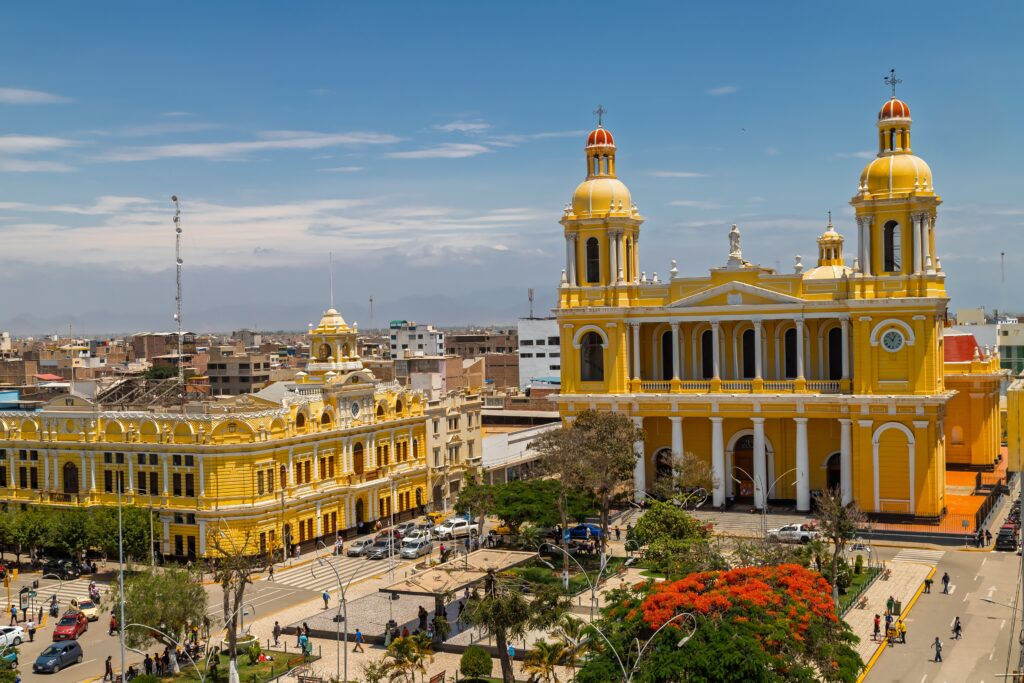
To the north, the city of Chiclayo lies within a land of ancient tombs and golden secrets. Here, the Lambayeque Valley has revealed treasures that rival those of Egypt — most famously, the tomb of the Lord of Sipán, an intact royal burial of the Moche civilization discovered in 1987.

The Royal Tombs of Sipán Museum, shaped like a stepped pyramid, showcases exquisite jewelry, ceramics, and regalia that speak of a people whose artistry glowed brighter than their gold. Nearby, the pyramids of Túcume, known as the Valley of the Pyramids, stretch across the plain — thirty-six adobe mounds that shimmer at sunset like dunes of time.
Chiclayo itself hums with life — a modern city of markets and music where history isn’t confined to museums. It breathes through every story told by its people, heirs to kingdoms buried yet unforgotten.
Cajamarca – Where Empires Met

High in the northern Andes, Cajamarca is a place of encounter — the site where Inca majesty met Spanish ambition. Here, in 1532, the Inca emperor Atahualpa was captured by Francisco Pizarro, sealing the fate of an empire. Yet the city today carries not sorrow, but resilience.

Its streets echo with bells from the Cathedral of Santa Catalina, its plazas lined with whitewashed houses and carved balconies. Hot springs known as the Baños del Inca still flow nearby — the same waters where Atahualpa bathed before destiny arrived.
Cajamarca’s countryside is pastoral and serene, dotted with dairy farms and patchwork fields. Time here moves gently, as if the land itself has chosen healing over history. In the soft Andean light, Cajamarca feels like Peru in miniature — proud, tragic, and endlessly beautiful.
Huaraz – Gateway to the Cordillera Blanca
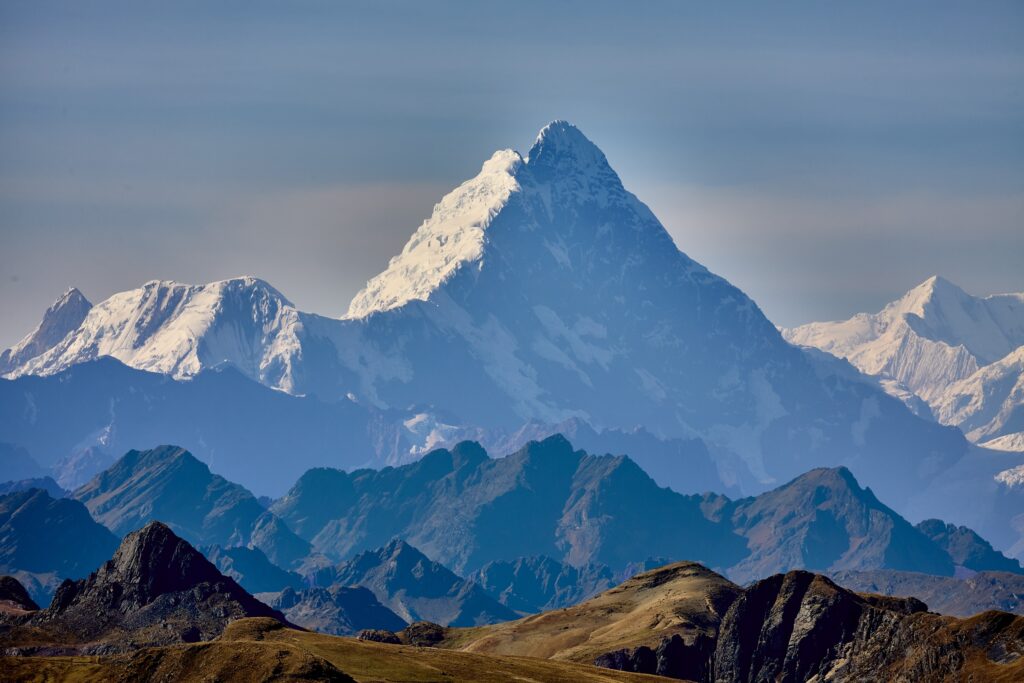
Few landscapes on earth rival the Cordillera Blanca, a range of ice and granite so majestic it seems drawn from myth. Nestled in its shadow lies Huaraz, a humble mountain town that serves as the heart of high-altitude adventure — and as a reminder of the Andes’ raw, transcendent power.
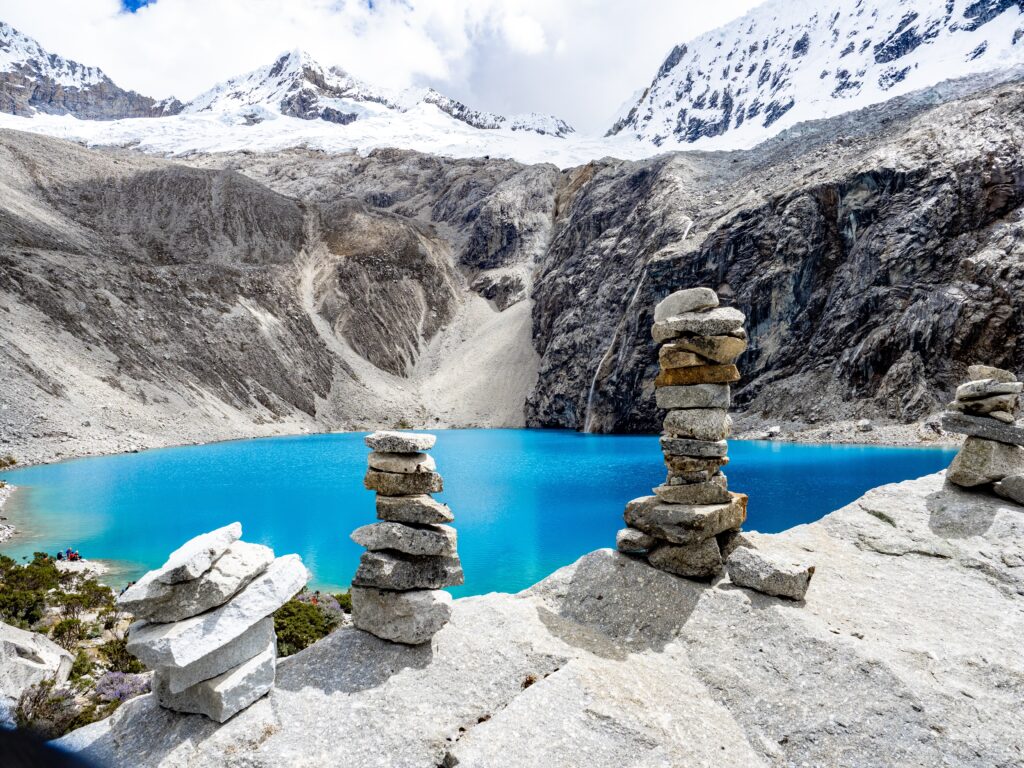
The nearby Huascarán National Park, a UNESCO World Heritage Site, protects more than 600 glaciers and 300 turquoise lakes, each reflecting peaks that pierce the heavens. Laguna 69, with its impossibly blue water, is a pilgrimage for trekkers and dreamers alike.
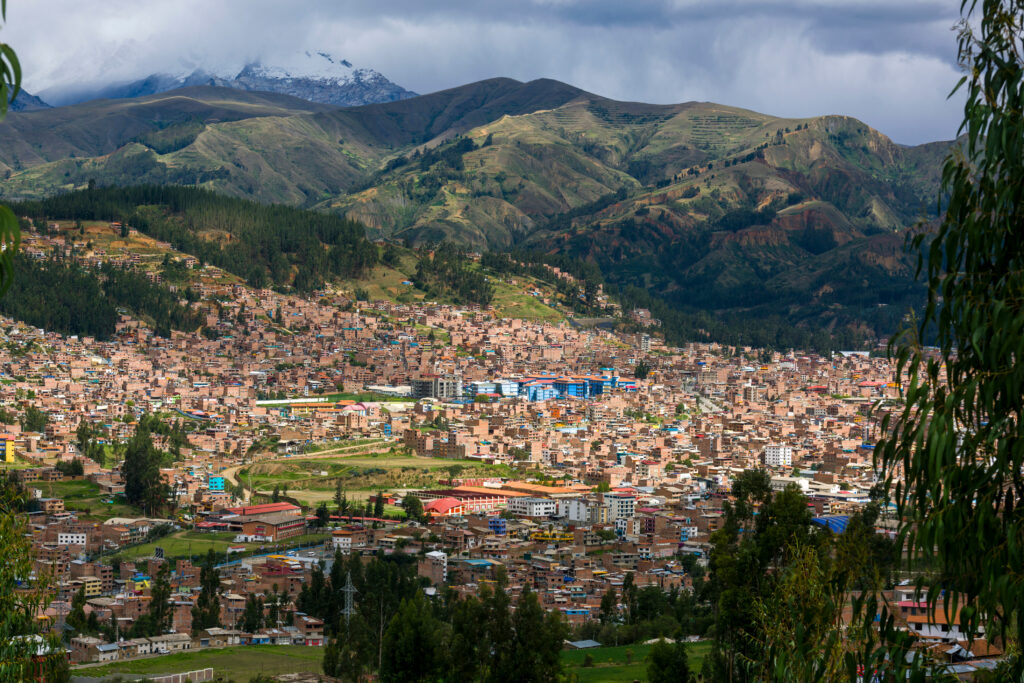
Huaraz bears the scars of earthquakes, yet endures with quiet pride. Its people live close to the mountains, their traditions shaped by altitude and faith. When the sun sets behind snow-crowned Huascarán, it feels as though the world itself is exhaling — and you understand why the Andes are not merely mountains, but guardians of spirit.
Huanchaco – Where Waves and Legends Meet

North of Trujillo lies Huanchaco, a tranquil seaside town where surfboards share the waves with ancient reed boats called caballitos de totora. These slender vessels — used by fishermen for more than 3,000 years — glide gracefully across the surf, linking the modern world to the Moche and Chimú civilizations that once thrived here.
Huanchaco is not merely a beach; it’s a living museum of Peru’s coastal culture. Along its golden shore, locals sell ceviche so fresh it still carries the scent of the sea, and the rhythm of the waves seems to echo an eternal lullaby. As the sun sets behind the Pacific, painting the sky in copper and violet, caballitos silhouette the horizon like shadows of history itself.
For surfers, Huanchaco is a haven of long left-hand waves; for travelers, it’s a pause — a place where time slows, where myth and motion merge, and where the Pacific feels less like an ocean than an old companion.
Ica & Huacachina – Oasis of the Desert

In the heart of Peru’s southern desert, between dunes that ripple like frozen waves, lies Huacachina — a small emerald lagoon surrounded by palm trees and sand mountains taller than cathedrals. Legend says it was born from a maiden’s tears, and even today it seems touched by enchantment.
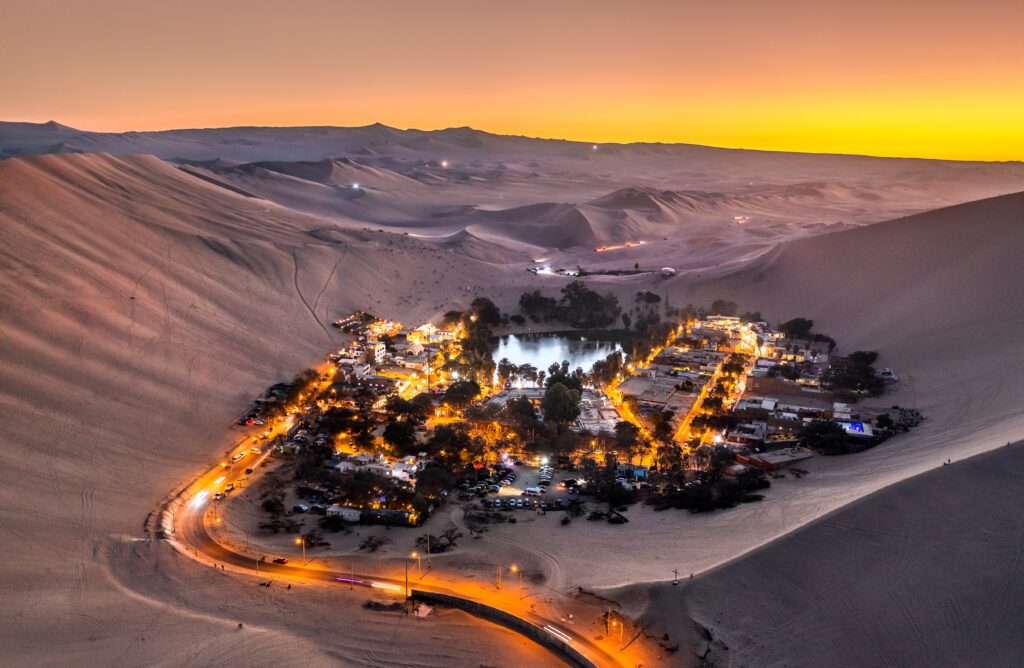
Nearby Ica is known for its vineyards and pisco distilleries, where Peru’s national spirit is crafted with sun, grape, and patience. Visitors wander among the old wine presses of Bodega Tacama or taste the burnished warmth of pisco puro straight from the still.

But it is Huacachina that steals the heart. At dusk, when the dunes catch fire in the sunset and sandboarders trace fleeting paths down their slopes, the desert feels alive. Beneath the starlit silence, you sense the pulse of something eternal — proof that even in the driest place, life finds its reflection.
Colca Canyon – Depths of the Condor’s Realm
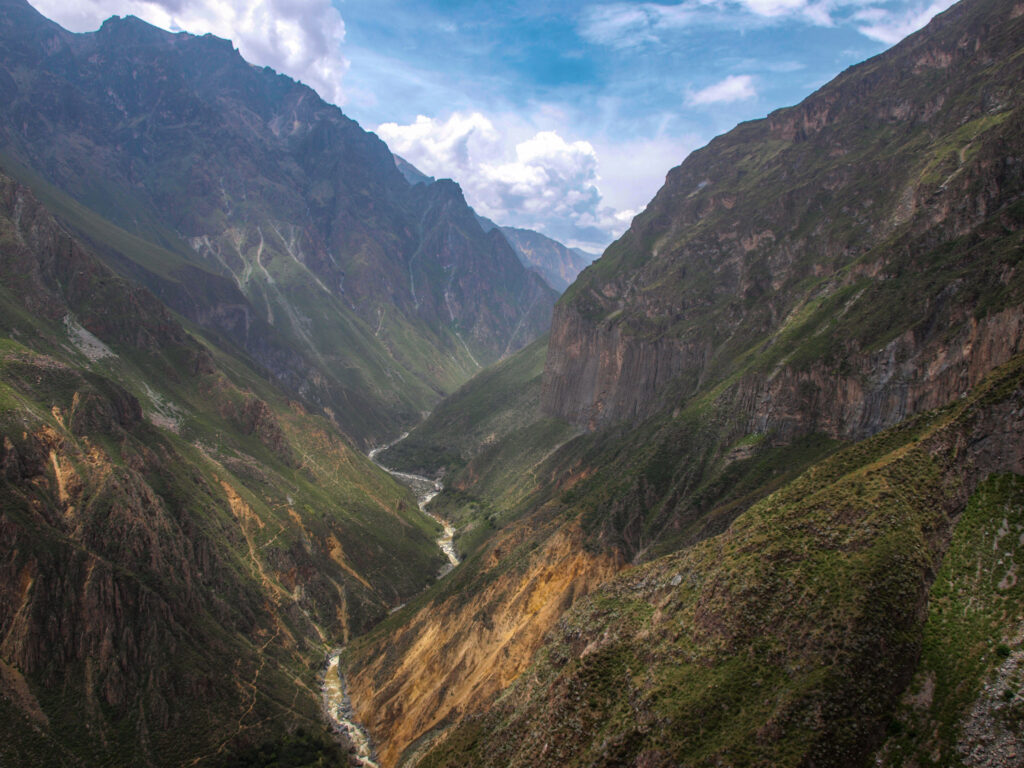
Twice as deep as the Grand Canyon, Colca Canyon is a cathedral carved by time. Terraces cling to its walls like steps to the sky, and the Colca River threads its way far below, shimmering in the sun’s thin light. Villages such as Chivay and Yanque preserve their Quechua roots, where women wear embroidered hats that tell their valley’s lineage, and children still speak the language of the Incas.

At dawn, travelers gather at Cruz del Cóndor, a lookout where the great Andean condors rise on thermals, their wings spanning ten feet or more. Watching them soar above the canyon’s abyss feels less like sightseeing and more like ceremony.
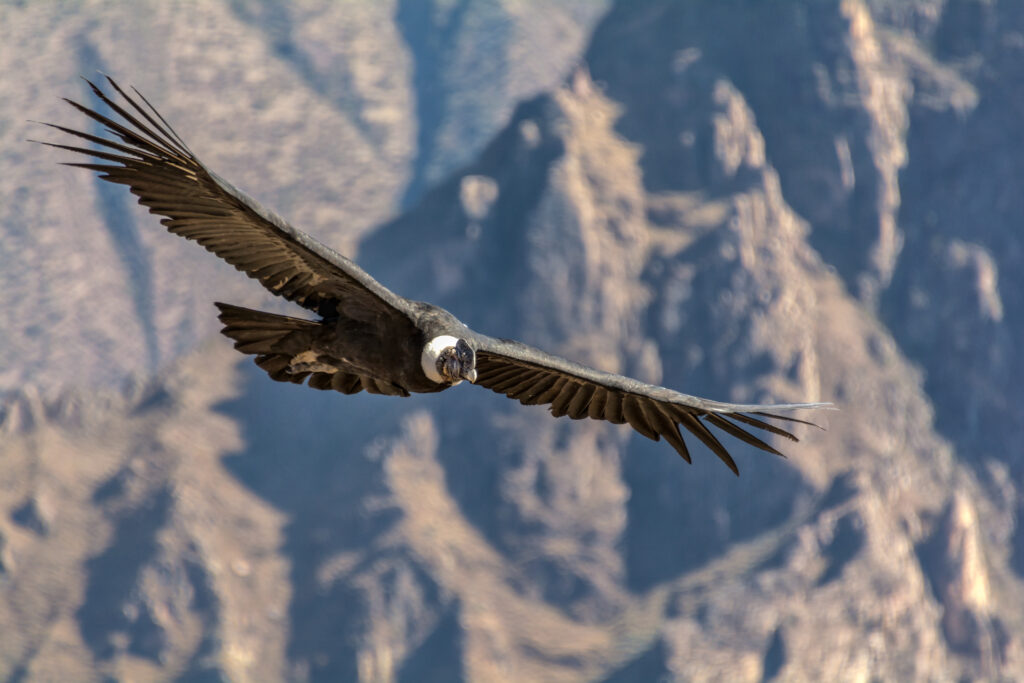
The air here is crisp, thin, and holy. To gaze across Colca is to feel small yet infinite — a fleeting part of a landscape that has known both gods and glaciers.
Tarapoto – City of Palms and Waterfalls

Deep in the northern Amazonian foothills lies Tarapoto, a tropical paradise where waterfalls tumble through lush valleys and rivers coil like silver serpents. Known as the City of Palms, it bridges the high Andes and the low jungle — a land where mountains exhale into mist and the air smells of orchids and rain.

Nearby, the Ahuashiyacu Waterfall cascades through emerald forest, its spray cool and sweet. In the surrounding villages, cacao and coffee are cultivated by hand, their aroma filling the air. The region is also the cradle of chanca de gallina and juanes, dishes that fuse Andean heartiness with jungle abundance.
Tarapoto embodies Peru’s quieter magic — wild yet welcoming, tropical yet spiritual. It’s a place where the rainforest begins to whisper its invitation, and every river seems to lead toward discovery.
Manu National Park – The Living Ark
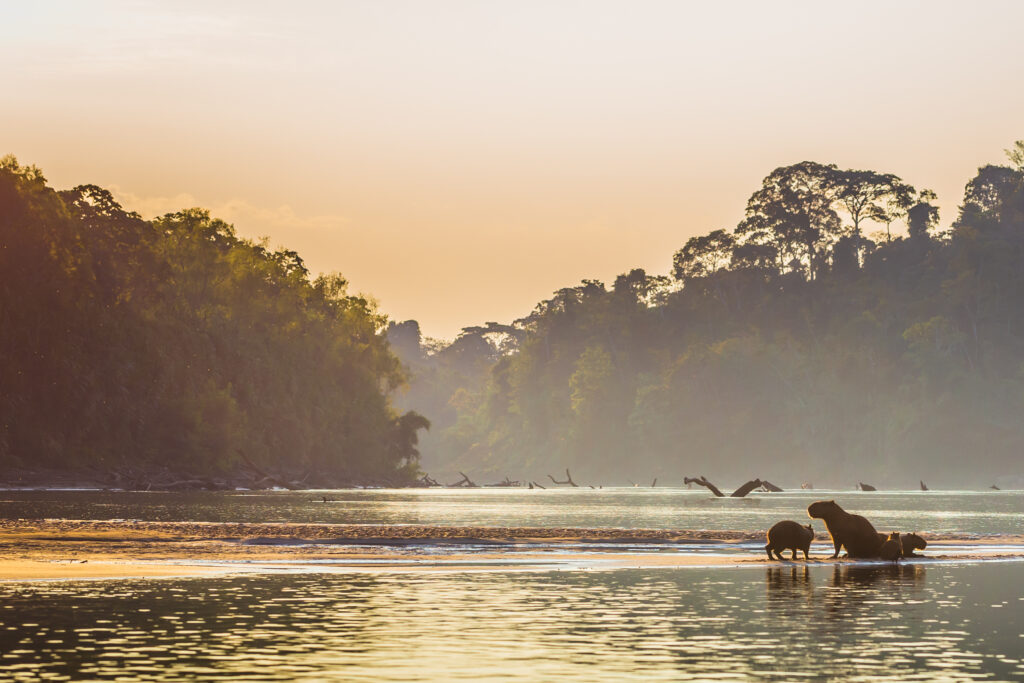
Few places on Earth embody the raw soul of nature like Manu National Park, a vast biosphere reserve stretching from the Andean cloud forests down into the Amazon Basin. Declared a UNESCO World Heritage Site, it shelters more species of birds and mammals than some entire continents — jaguars, macaws, tapirs, and monkeys of colors the mind can barely imagine.

Traveling through Manu feels like entering a primordial world. Mist drifts through the treetops; parrots gather at clay licks; giant otters glide through oxbow lakes in perfect silence. The rhythm of the forest is slow, timeless, humbling.
In its remoteness lies its purity. Villages here live in harmony with their surroundings, guided by knowledge passed down over generations. Manu is not merely a park; it is a living ark — proof of the Earth’s resilience, and a reminder that paradise still breathes.
Ayacucho – The City of Churches and Resurrection
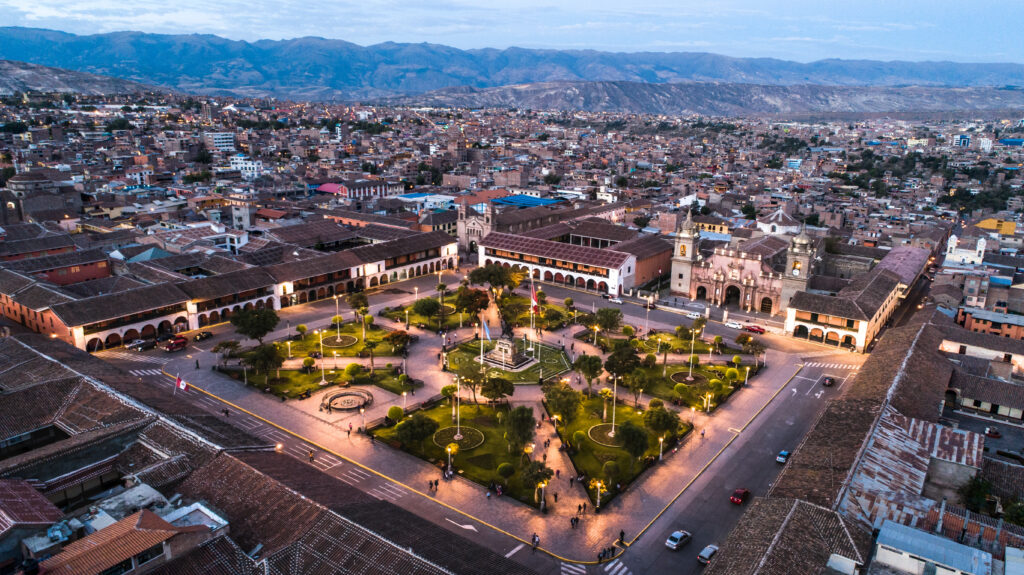
High in the southern Andes, Ayacucho glows with solemn grace — a city of cobbled streets, terracotta roofs, and no fewer than thirty-three colonial churches, one for every year of Christ’s life. But beneath its tranquil beauty lies a story of endurance: Ayacucho was both the cradle of independence and the witness to Peru’s hardest years of conflict.
Today, it has transformed suffering into art. Its artisans craft luminous retablos — wooden boxes filled with miniature figures that depict scenes of daily life, faith, and peace. During Semana Santa, Holy Week, the city bursts into light and song, its processions among the most beautiful in Latin America.
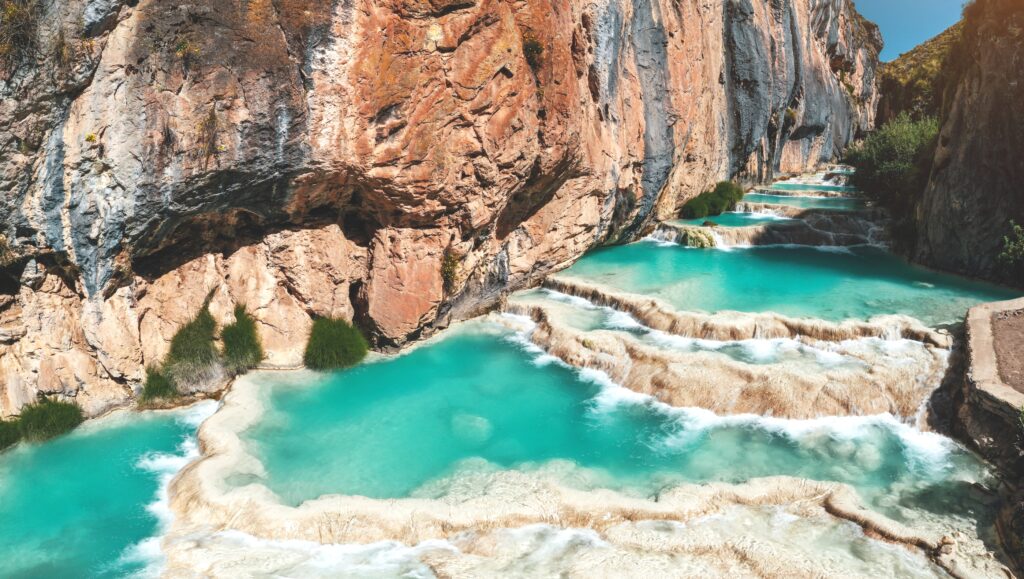
Above Ayacucho, the Wari ruins recall the empire that predated the Incas, while the surrounding valleys bloom with eucalyptus and prayer. This is a city reborn — one that teaches how faith, in every form, can outlast even sorrow.
Chachapoyas & Kuelap – The Cloud Warriors’ Fortress

Hidden in the cloud forests of northern Peru, Kuelap rises like a dream sculpted from stone. Built by the Chachapoya, the “Warriors of the Clouds,” centuries before the Incas, it perches upon a mountain ridge 3,000 meters above sea level, its walls as high as medieval castles.
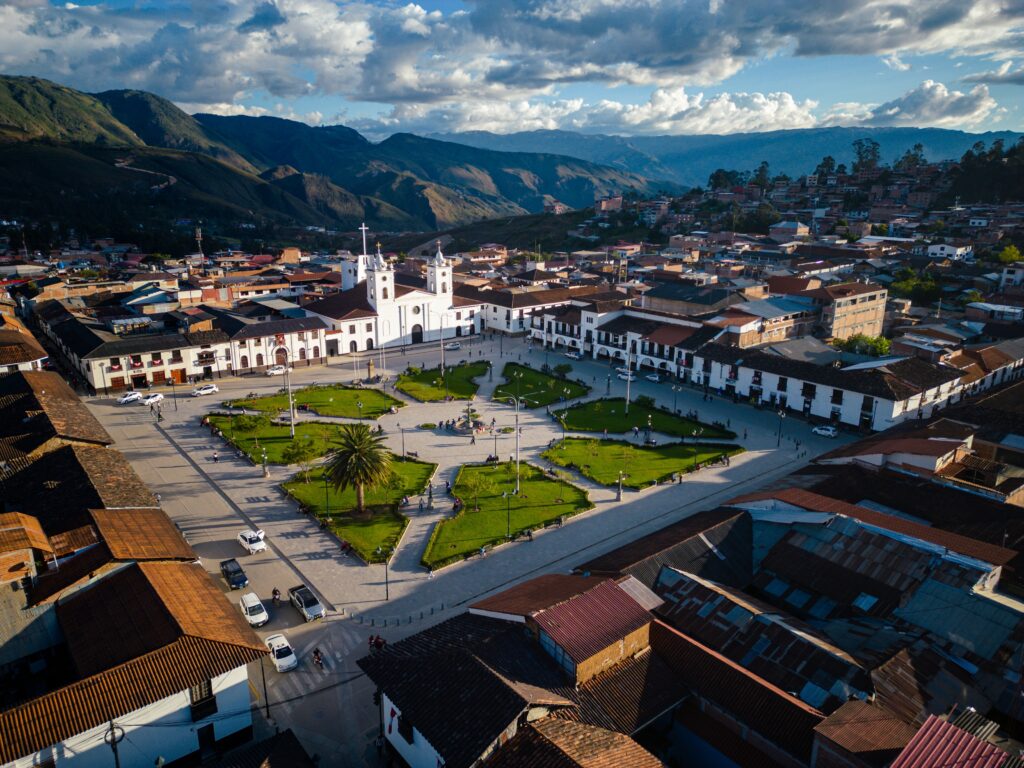
Unlike Machu Picchu’s harmony, Kuelap feels mysterious, solemn — its circular dwellings and serpent-carved stones wrapped in perpetual mist. The fortress protected an entire civilization that vanished into legend, leaving behind a monument to both strength and fragility.
The nearby town of Chachapoyas is a quiet gateway to this world — colonial balconies overlooking green valleys and waterfalls that seem to descend from the heavens. To reach Kuelap is to journey not just through geography, but through time — into a lost kingdom reclaimed by the clouds.
Piura – Where the Sun Never Sets
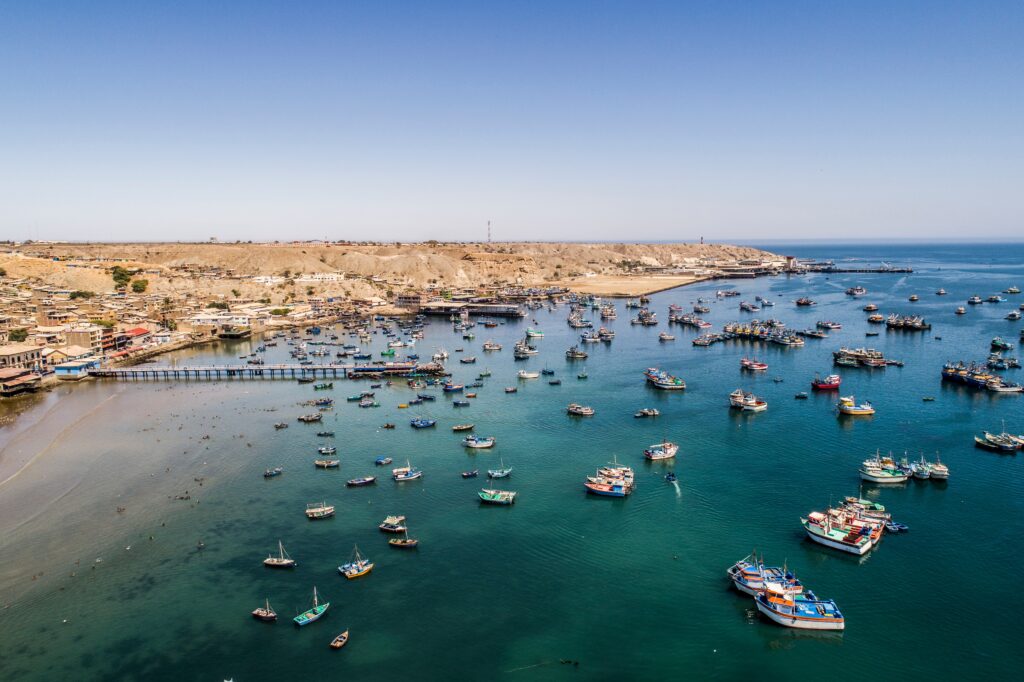
On the northern coast, Piura basks in warmth and light, earning its name as the Ciudad del Eterno Calor — the City of Eternal Summer. It was the first Spanish settlement in South America, yet its spirit is wholly Peruvian: vibrant, musical, and joyful.

The beaches of Máncora and Los Órganos stretch northward, kissed by golden light and some of the best surf in the continent. Inland, carob forests hum with cicadas, and artisans weave delicate straw hats and bright cotton fabrics that capture the region’s sunlit soul.

Piura’s cuisine mirrors its character — exuberant and flavorful. Seco de cabrito (goat stew), ceviche de mero, and algodón de azúcar sweeten every gathering. Life here feels effortless, suspended between sea and desert, always basking in the warmth of a sky that never seems to fade.
Tumbes – Gateway to the Tropics
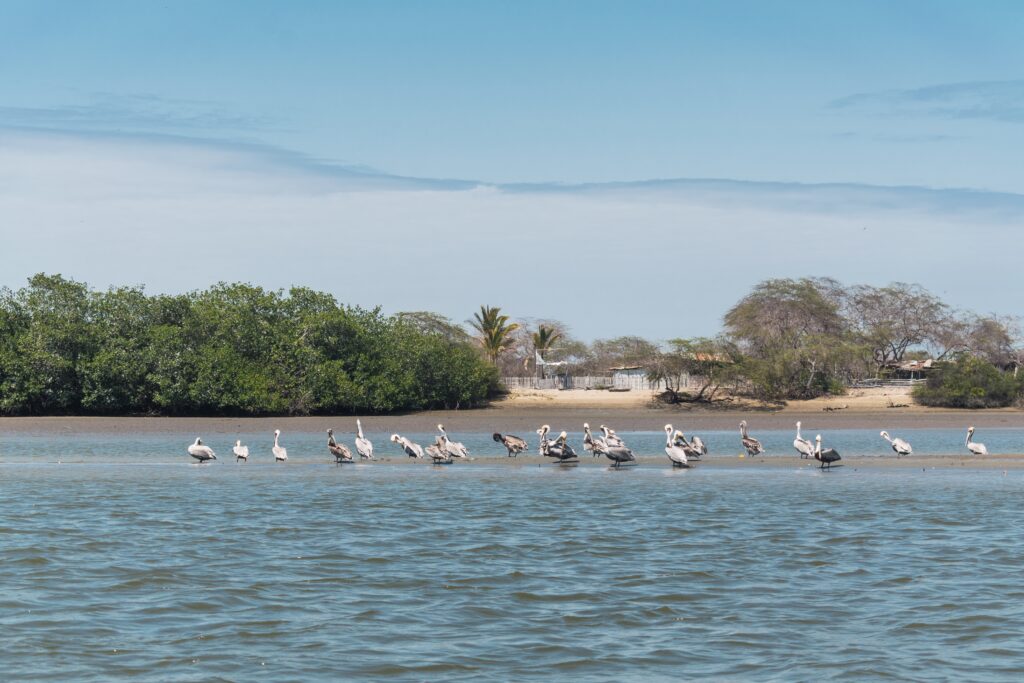
At Peru’s northernmost tip lies Tumbes, where the Pacific turns emerald and mangroves weave a living labyrinth between sea and jungle. It’s a land of transition — where desert ends, tropic begins, and life explodes in color.

The Manglares de Tumbes National Sanctuary protects a fragile ecosystem teeming with crocodiles, herons, and scarlet crabs that move like blossoms across the mudflats. Offshore, beaches such as Zorritos and Punta Sal offer serenity under a sun that feels eternal.
Tumbes was the first Peruvian land touched by the Incas, and later by the Spanish — a symbolic threshold between epochs. Today, it feels both remote and radiant: a place where the ocean still speaks the language of origin, and every tide carries echoes of beginnings.
Gocta Waterfall – The Hidden Giant
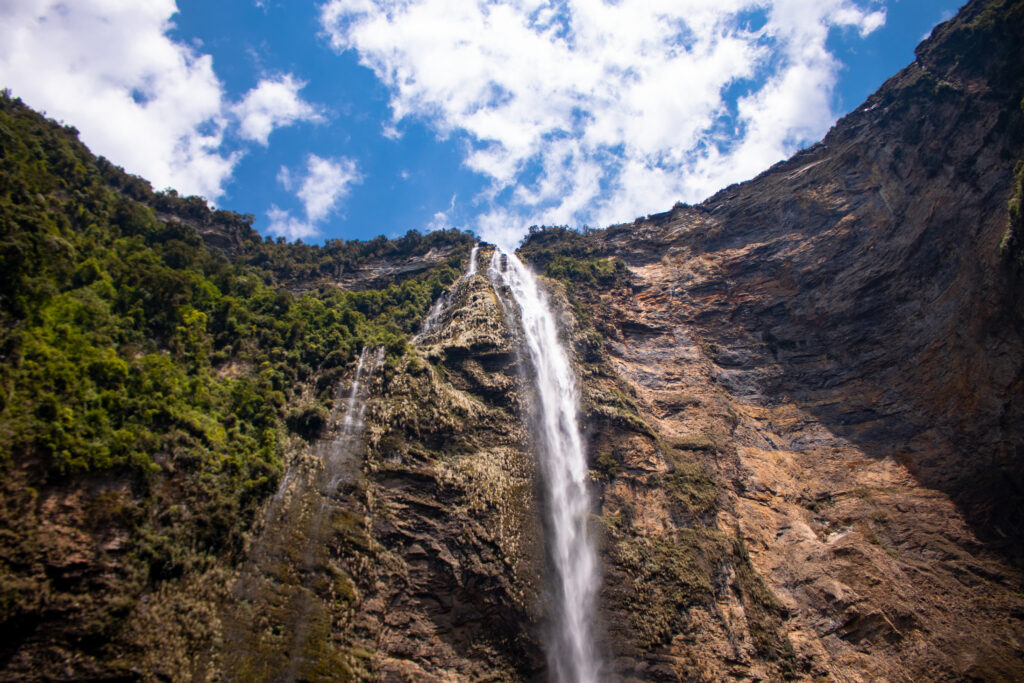
Until 2005, the world did not know that one of its tallest waterfalls lay hidden in the forests of northern Peru. Gocta Falls, plunging over 770 meters in two tiers, had been kept secret by locals who believed the spirit of a golden-haired woman guarded its waters.
Reaching Gocta requires a hike through cloud forest alive with orchids, hummingbirds, and the rustle of rain. The first glimpse of the falls — mist rising like smoke from the jungle — is unforgettable. The sound is thunder made visible; the sight, almost celestial.
In the nearby village of Cocachimba, time slows. From simple lodges, you can watch dawn light touch the cliffs, and by evening, hear the endless roar become lullaby. Gocta is more than a waterfall — it’s a revelation of nature’s patience, a reminder that even miracles can hide in plain sight.
Pachacamac – The Temple of the Sun and the Moon

Just south of Lima, on a barren plain overlooking the Pacific, stand the sacred ruins of Pachacamac, one of Peru’s most powerful pre-Incan pilgrimage sites. For over a thousand years, worshippers from across the Andes came here to consult the oracle of the god Pachacamac — creator of earthquakes and giver of life.
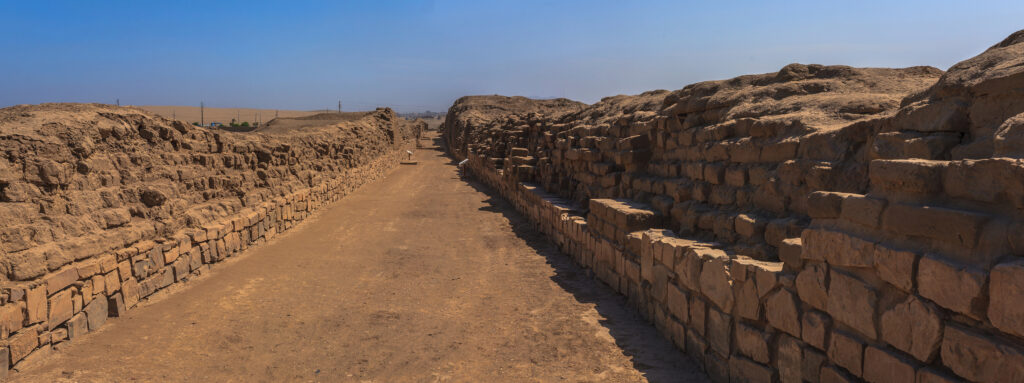
Today, its adobe pyramids still rise from the dust like echoes of devotion. As the afternoon light burns gold over the sea, it’s easy to imagine the priests ascending the stairways, the air filled with chants and incense. The Temple of the Sun, rebuilt by the Incas, gazes westward — a perfect alignment between earth, fire, and ocean.
Few places speak so clearly of continuity — where layers of faith, conquest, and rebirth coexist. Pachacamac reminds visitors that Peru’s sacred geography extends beyond Machu Picchu — that even the desert once trembled with prayer.
Lunahuaná – The River of Adventure and Wine

Tucked into the fertile valley of the Cañete River, Lunahuaná is where adrenaline meets abundance. Here, the Andes loosen into green foothills, and vineyards lace the valley floor with silver leaves. It’s one of Peru’s adventure capitals — white-water rafting, paragliding, mountain biking, and zip-lining all unfold under a blazing sun.
But Lunahuaná is not only for thrill-seekers. Its colonial town square, lined with pisco bodegas, invites long afternoons of tasting and conversation. The local nectar — vino borgoña and pisco Italia — reflects centuries of craft. Nearby, the Inca site of Incahuasi whispers of ancient garrisons and royal roads.
As dusk falls and the river’s roar softens to a lull, Lunahuaná reveals its true charm: a place where joy feels natural, where mountains, water, and wine conspire to celebrate life itself.
Paucartambo – The Festival of the Virgin of Carmen

Each July, the quiet Andean town of Paucartambo bursts into color and rhythm during one of Peru’s most extraordinary folk festivals — the Fiesta de la Virgen del Carmen. For three days and nights, masked dancers whirl through the cobblestone streets, representing devils, colonizers, angels, and Andean spirits in a spectacle that blurs heaven and earth.
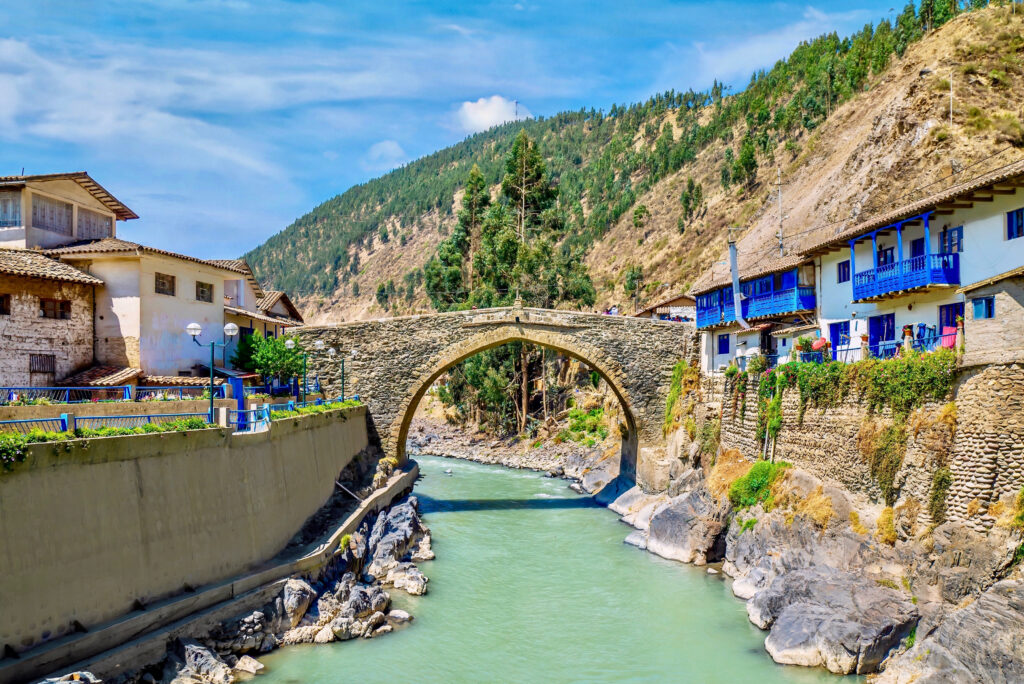
The celebration, rooted in both Catholic devotion and Inca tradition, transforms the town into living theatre. Costumes shimmer with mirrors and embroidery; fireworks paint the sky above the colonial bridge. Pilgrims sleep under balconies, musicians play through dawn, and joy becomes almost sacred.
From Paucartambo, the road climbs toward Tres Cruces, a viewpoint where the Andes descend into the Amazon. At sunrise, light bends into three suns — a rare optical illusion the locals call a blessing. To witness it is to see Peru’s essence: faith, nature, and mystery intertwined.
Iquitos – City of the Amazon

There is no road to Iquitos. The largest city in the world unreachable by land, it floats amid the vast green sea of the Amazon rainforest, accessible only by river or air. Life here moves to the rhythm of the water — ferries glide down the Marañón, markets overflow with exotic fruits, and jungle birds cry through the humid air.
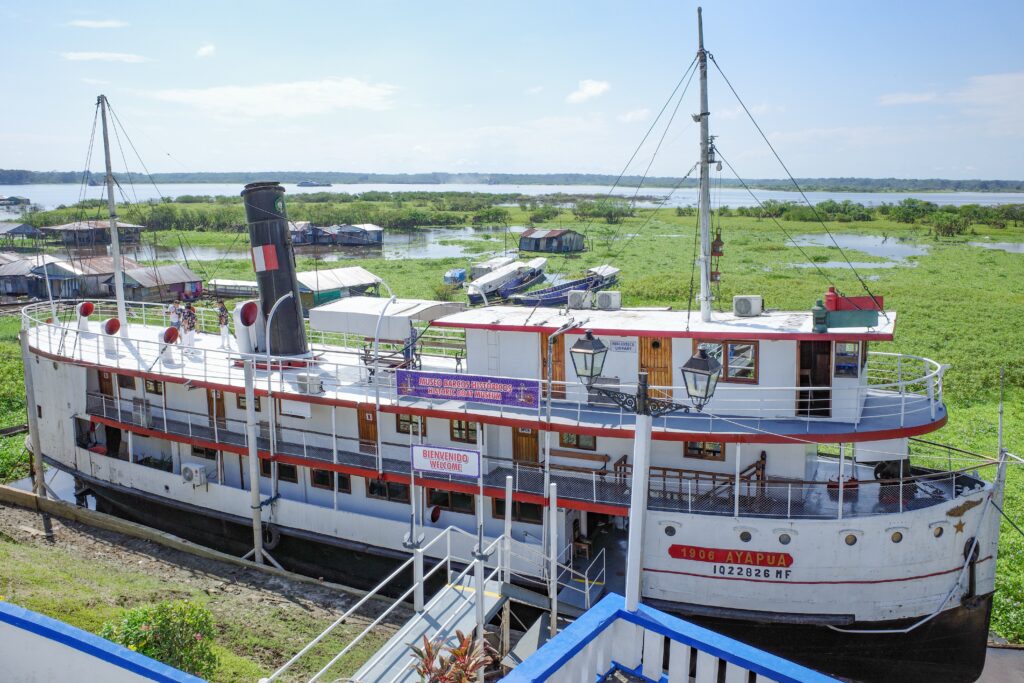
Iquitos was built on the wealth of rubber in the late 19th century, leaving behind opulent mansions with mosaic facades imported from Europe. Today, it is a gateway to adventure: lodges on the Amazon River, encounters with pink dolphins, visits to Indigenous communities, and treks beneath trees taller than cathedrals.

At sunset, the river mirrors the sky in molten gold. Iquitos is not only a destination — it is a reminder of the Amazon’s power, fragility, and endless wonder.
Cordillera Huayhuash – The Sacred Spine of Ice
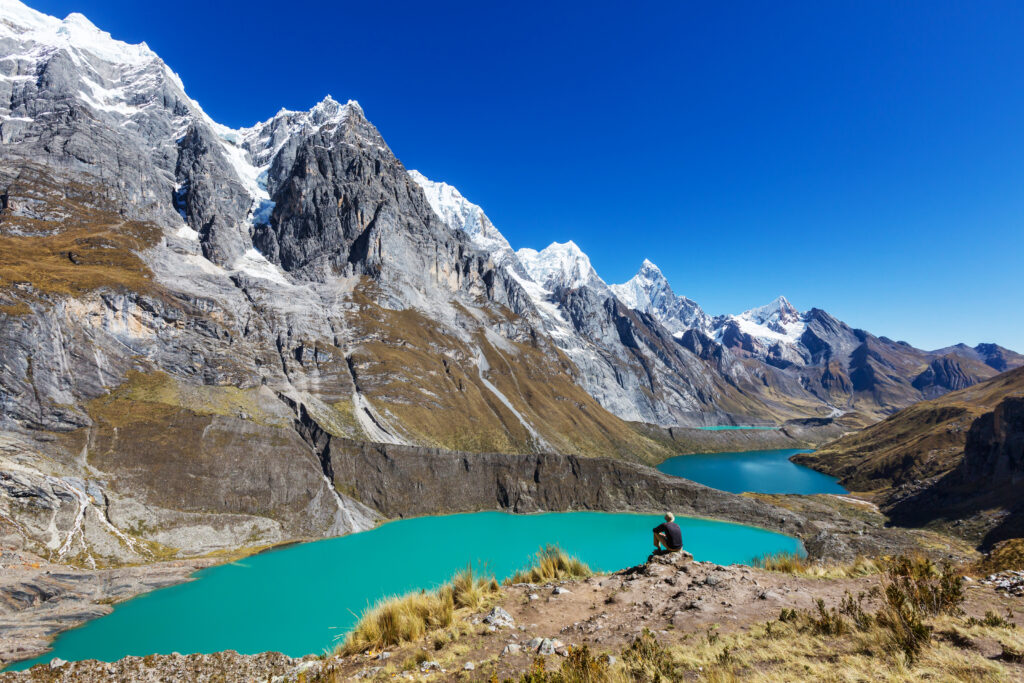
For those who seek the sublime, the Cordillera Huayhuash in northern Peru offers one of the most breathtaking mountain circuits on Earth. A crown of peaks soaring above 6,000 meters — Yerupajá, Siula Grande, and Rasac — reflected in turquoise lakes so clear they seem unreal.
Trekkers spend days surrounded by silence so pure it feels eternal. Villages of shepherds dot the high valleys, where alpacas graze under the gaze of snow and stars. This is the landscape of legends — immortalized in tales of endurance like Touching the Void — but beyond adventure, it is also a sanctuary.
Here, the Andes reveal their truest self: not only a barrier but a backbone, ancient and alive. The Huayhuash teaches humility — that beauty, at its highest, demands reverence.

